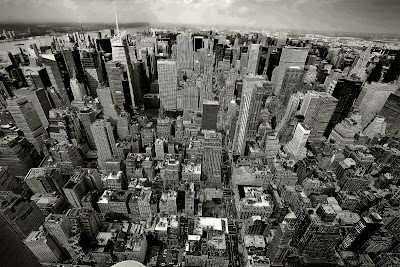Just high
enough to get that perfect view from the window seat when you fly on that
aircraft? When the buildings were taller than you, and then they gradually seem
smaller, and the within fractions of minutes they look tiny; almost unreal,
like those models you’ve seen made by architects? They actually seem to be made
of styrofoam and cardboard, trees made of colored sponge stuck on sticks. The
whole town looks like a miniature project we often made in our schools when we
were young. And then suddenly as we cruise to greater heights, it all becomes a
haze. And you don't see it anymore…
 |
| the world seems so different from above... doesn't it? |
A lot happened
without you realizing it. The cracks on the building became less evident. The
dirt and the sewage became invisible. The traffic didn't seem that bad on the
streets. The sea didn't seem so dark. For some reason, everything looked
beautiful. A bird’s eye view changes perspectives. When you learn to zoom out,
you see a LOT beyond and around your usual narrow focus. You almost get a
panoramic view of things. It’s a whole new introduction to the Gestalt…
What is Gestalt?
Gestalt’s
principle emphasizes that the ‘whole' is different from the ‘sum of it’s parts’.
When you break something it should ideally represent parts of the same whole.
But it doesn't. Just like those pieces of furniture and lighting and upholstery
and flooring and wall colors, which were all definitely lovely when your
architect bought them at the store; but once the home was assembled together
with these ‘parts’, it did greater justice to the beauty of the entire house.
The whole décor suddenly seemed like it was all custom made to perfection for
adorning your home. That bird’s eye view helps you change your viewpoint and
appreciate things because you ‘look’ at them differently. Sometimes you need to
zoom in to see them precisely, at others you need to zoom out to see them in their
altered perspective.
How does it help?
Zoom out every
time you are worried or stressed or tense. When the trouble is visited from
high up in the sky (that aircraft window), it somehow seems miniscule, like its
not even real. It’s just a little cardboard or styrofoam problem. It doesn't look
worrisome. Learn to break it so that you don't see one big elephant in your
room. You probably see just a little squirrel. And that seems pretty harmless
to you doesn't it?
But the problem doesn't go away!
That is most
certainly true, when you view it like this, it doesn't vanish. It is what it
is; you just begin to see it differently. Most problems worry us, not because
of their magnitude, but because of the emotions they arouse in us that lead to
the enormity we make of them. If we could keep an unruffled mind through
troubles, they would always seem like small hitches not big hurdles. Changing
perspectives practically changes nothing in the ‘real’ sphere. But again, there
is no ‘real’ sphere here. A problem for you may be a moment of festivity for
another. It’s all about perspective again. It is wise to use your head to find
solutions to troubles and not use your heart to badger yourself down with worry
and apprehension. Perspective helps you to keep your calm and use your
intellect to make the best of what you have. It rather ‘prevents’ you from
losing that level headedness in a bout of emotional turmoil.
See right, feel right, do right
See your
problems as the speck in the ocean; a single rough wave doesn't destroy the
peace of the profound waters (it shouldn’t!). Don't react negatively to them
(anger, worry, depression are all negative and inappropriate emotions). Act
positively (use problem solving strategies, seek help, brainstorm and reach
favorable outcomes)
You need problems; if there were no problems you’d
never find solutions!
No comments:
Post a Comment